The Corsair Neutron NX500 (400GB) PCIe SSD Review: Big Card, Big Pricetag
by Billy Tallis on August 16, 2017 10:00 AM ESTRandom Read Performance
Our first test of random read performance uses very short bursts of operations issued one at a time with no queuing. The drives are given enough idle time between bursts to yield an overall duty cycle of 20%, so thermal throttling is impossible. Each burst consists of a total of 32MB of 4kB random reads, from a 16GB span of the disk. The total data read is 1GB.

The QD1 burst random read speeds of the Phison E7 drives are all over the chart. The Corsair Neutron NX500 ranks just above the middle, while the Patriot Hellfire is the second-fastest drive in the bunch. With the exception of the underperforming Zotac SONIX and the SATA-based 850 PRO, this chart shows clear separation between the MLC and TLC drives.
Our sustained random read performance is similar to the random read test from our 2015 test suite: queue depths from 1 to 32 are tested, and the average performance and power efficiency across QD1, QD2 and QD4 are reported as the primary scores. Each queue depth is tested for one minute or 32GB of data transferred, whichever is shorter. After each queue depth is tested, the drive is given up to one minute to cool off so that the higher queue depths are unlikely to be affected by accumulated heat build-up. The individual read operations are again 4kB, and cover a 64GB span of the drive.
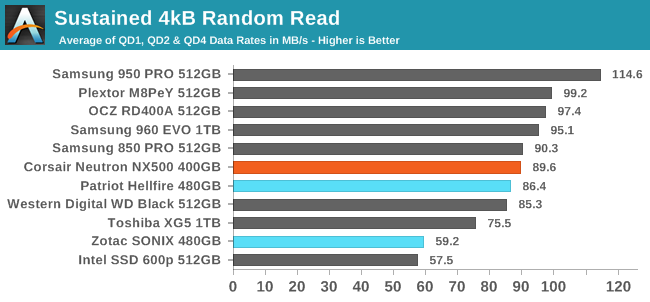
On a longer test that includes some moderately higher queue depths, the NX500 comes out on top among the Phison E7 drives, but it is a bit below average compared to the market as a whole.

The power efficiency of the NX500 is not quite competitive with the Patriot Hellfire M.2, and nowhere close to most of the 3D NAND SSDs.
 |
|||||||||
The Corsair Neutron NX500's random read performance scales at higher queue depths much better than the other Phison E7 SSDs, but even at QD32 it is slower than Toshiba's own OCZ RD400 using the same NAND.
Random Write Performance
Our test of random write burst performance is structured similarly to the random read burst test, but each burst is only 4MB and the total test length is 128MB. The 4kB random write operations are distributed over a 16GB span of the drive, and the operations are issued one at a time with no queuing.
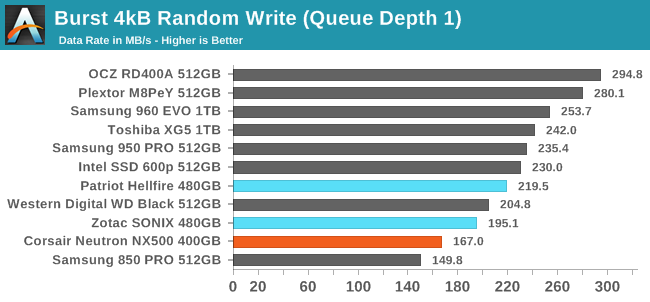
The burst random write speed of the Corsair Neutron NX500 is far below what it should be. Both of the other Phison E7 drives are substantially faster and yet still slower than even the Intel SSD 600p.
As with the sustained random read test, our sustained 4kB random write test runs for up to one minute or 32GB per queue depth, covering a 64GB span of the drive and giving the drive up to 1 minute of idle time between queue depths to allow for write caches to be flushed and for the drive to cool down.
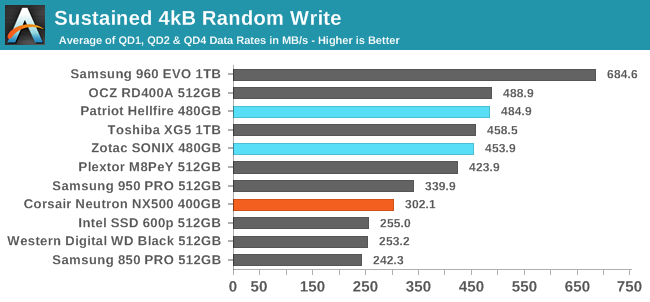
With a longer test and bringing in some higher queue depths, the Intel 600P and WD Black fall below the NX500, but the NX500 is still performing much worse than the other Phison E7 SSDs or any other MLC NVMe SSD. The Patriot Hellfire is basically tied for second place behind Samsung.
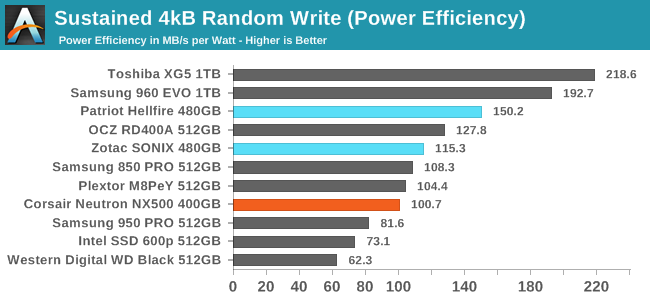
The NX500's power efficiency during random writes isn't great, but it's only slightly worse than some of the competing NVMe MLC drives and is substantially better than the entry-level NVMe TLC drives.
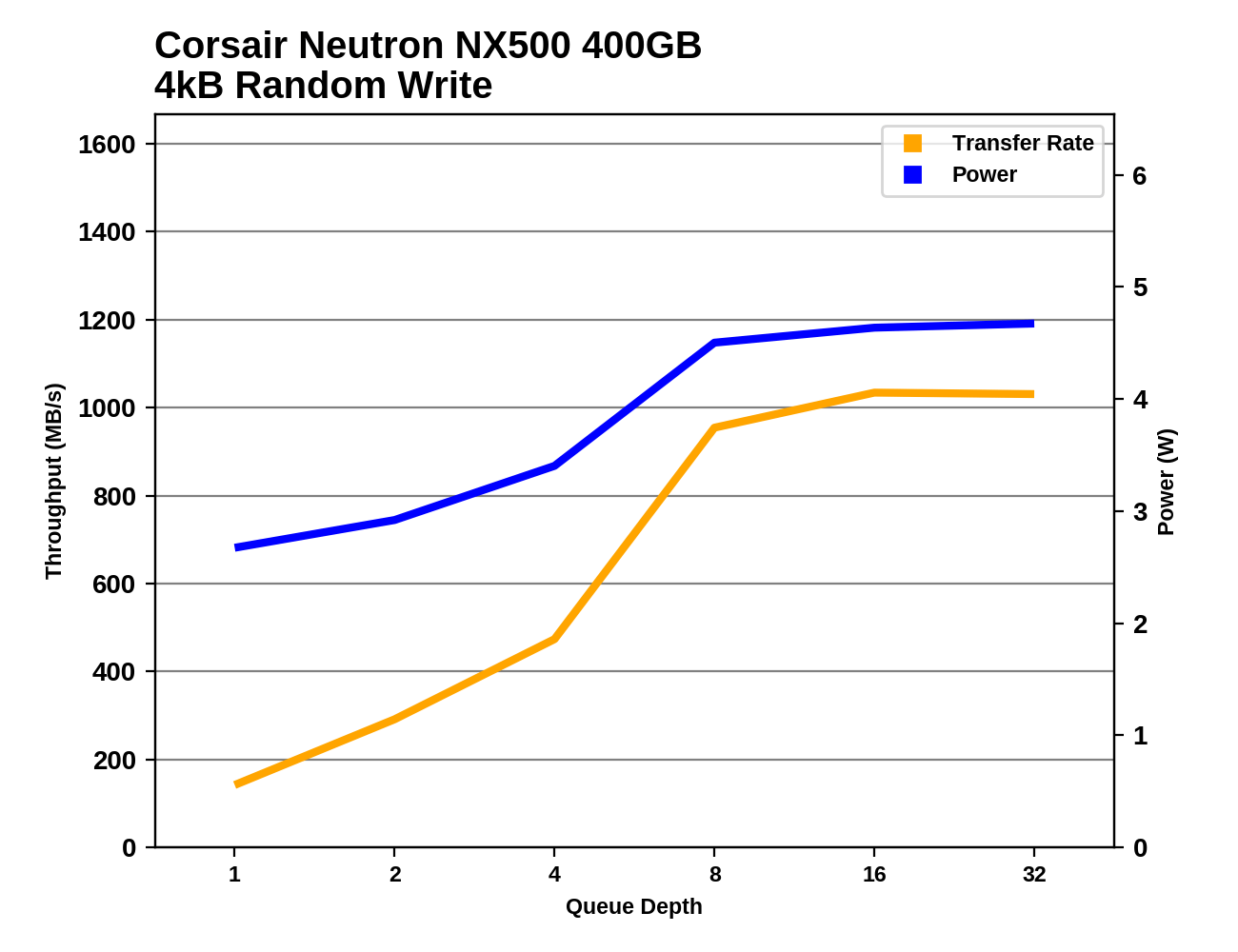 |
|||||||||
The NX500's random write speed does reach decent levels at queue depths of 8 or higher, but at the low queue depths that matter for real-world desktop performance, the NX500 is way behind.










45 Comments
View All Comments
Exodite - Wednesday, August 16, 2017 - link
I'm looking forward to the day I can read a SSD review and not come away thinking "...or just buy a Samsung".Not that I begrudge them top spot, they've clearly put the work into it, but as consumers we'd be better served if at least /someone/ else were competing on, like, any metric.
Ej24 - Wednesday, August 16, 2017 - link
Crucial used to be in the game back when Sata SSD's were king, then they just never released another MLC drive, nor any consumer nvme drives. So yeah, Samsung is definitely unchallenged now. Though that Toshiba xg5 kept up well in the destroyer benchmark.coolhardware - Wednesday, August 16, 2017 - link
Agreed. Samsung has been at the top for so long it is just boring.Kudos to Samsung though for making some fast and reliable SSDs at a reasonable price point.
Lolimaster - Wednesday, August 16, 2017 - link
I think we got more chances to see GloFo AMD branded SSD better than the 850 than waiting for the known competitors.Samus - Wednesday, August 16, 2017 - link
Crucial is still in the game. They just can't compete with Samsung on performance. Nobody can.But in my experience, Crucial/Micron drives are slightly more reliable that Samsung (obviously excusing the flawed 840\840 EVO) especially in regard to power loss scenarios. That's why you continue to see more Micron drives in enterprise and business PC's than any other brand (except perhaps Sandisk, in which case they are often the same Marvell controller so the differentiating factor comes down to firmware and in-flight data protection)
It's really hard to consider anything else when looking at "new" drives. Samsung and Crucial/Micron are really at the top. Sandisk is decent, but not cost competitive at the high end, and OCZ's has had some good drives for the price lately, but why gamble?
And if you are looking for cheap MLC drives, older Intel drives are still the best bet. I still have a soft spot for SSD320's and SSD710's if you can live with the 3Gbps interface they are bulletproof and incredibly cheap on fleabay.
DigitalFreak - Wednesday, August 16, 2017 - link
"That's why you continue to see more Micron drives in enterprise and business PC's than any other brand (except perhaps Sandisk, in which case they are often the same Marvell controller so the differentiating factor comes down to firmware and in-flight data protection)"Maybe it's the particular vendor, but the Dell and Cisco equipment I deal with in both the server and desktop space use mainly Samsung, with some Toshiba XG series on the client side.
tipoo - Wednesday, August 16, 2017 - link
It's maybe ironic the only one challenging them on SSD speed isn't selling SSDs outside their own systems, i.e the last custom Apple SSD controller.tipoo - Wednesday, August 16, 2017 - link
Actually I'd love to see that put through this suite.extide - Wednesday, August 16, 2017 - link
Well at least I can be satisfied knowing I made a good investment buying my 1TB 960 EVO -- heck I think I paid around $400 - $450 or so for it -- cheaper than the 800GB version of this. It makes reviews boring but at the same time it sucks spending good money on something and then seeing something cheaper and faster released shortly after, although I do agree that we need to see some competition.beginner99 - Thursday, August 17, 2017 - link
Yeah. Perfromance is one thing but price another and this drive is clearly overpriced. If you want me to use a pcie-card ssd you better deliver something special but this fails.What's missing is a strady-state bench. First the large spare area gets praised but then no steady-state data? IMHO that is usually the most important aspect of the review, the actual performance the drive will have not some "marketing" numbers.